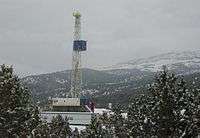Piceance Basin
The Piceance Basin is a geologic structural basin in northwestern Colorado, in the United States. It includes geologic formations from Cambrian to Holocene in age, but the thickest section is made up of rocks from the Cretaceous Period. The basin contains reserves of coal, natural gas, and oil shale.
Natural gas

The basin has come to increasing public attention in recent years because of widespread drilling to extract natural gas. The primary target of gas development has been the Williams Fork Formation of the Mesaverde Group, of Cretaceous age. The Williams Fork is a several-thousand-foot thick section of shale, sandstone and coal deposited in a coastal plain environment. The formation has long been known to contain natural gas. The sandstone reservoirs have low permeability and limited areal extent, however, which made gas wells uneconomic in the past.
In 1969 an atomic device was detonated in a well drilled into the Williams Fork Formation southwest of Rifle, Colorado in an attempt to fracture the rock and enable commercial extraction of natural gas. Project Rulison, as it was called, was a failure.
Advances in hydraulic fracturing within the past decade, along with higher gas prices, have made gas wells broadly economic in the area. In 2007 the basin contained five of the top 50 US gas fields in proved reserves (Grand Valley #16, Parachute #24, Mamm Creek #27, Rulison #29, and Piceance Creek #46).[1]
Increased gas drilling in recent years has been criticized by some. There is strong criticism of drilling for gas in previously undeveloped areas such as the Roan Plateau.
Oil shale
Increasing demand for energy resources has spurred interest in energy alternatives such as oil shale. The Piceance Basin contains one of the thickest and richest oil shale deposits in the world and is the focus of most on-going oil shale research and development extraction projects in the U.S. The Piceance Basin has an estimated 1.525 trillion barrels of in-place oil shale resources. This study also found an estimated 43.3 billion tons of in-place nahcolite resources in the Piceance Basin. This mineral is embedded with oil shale in many areas.
On 2 April 2009 The U.S. Geological Survey updated its assessment of in-place oil shale resources in the Piceance Basin in western Colorado. This new assessment is about 50 percent larger than the 1989 assessment of about one trillion barrels. Almost all of this increase is due to assessments of new geographic areas and subsurface zones that had too little data for previous research and assessments. "For the first time in 20 years, we have an updated assessment of in-place oil shale in the Piceance Basin of Colorado," said US Secretary of the Interior Ken Salazar. "The USGS scientific report shows significant quantities of oil locked up in the shale rocks of the Piceance Basin. I believe it demonstrates the need for our continued research and development efforts."[2]
General information on oil shale
Oil is obtained when oil shale rock is heated to 530° to 930 °F (276°to 498 °C). These temperatures are required because oil shale does not contain crude oil but instead contains kerogen, which is an organic precursor to oil that must be heated for oil production. Development of oil shale has significant technological and environmental challenges and no economic extraction method is currently available in the U.S. Therefore, it is unknown how much of the assessed in-place (total amount present) resource is recoverable.
The United States Geological Survey (USGS) has researched the geology of oil shale, especially the extensive Green River deposits of Colorado, Utah, and Wyoming. Planned products include digital-format shale-oil analyses, stratigraphic and lithologic information, geophysical logs, bibliographic references, and geologic maps of oil shale lands in the western United States.
See also
References
- ↑ US Energy Information Administration: Top 100 oil and gas fields, Table B2, PDF file, retrieved 19 February 2009.
- ↑ USGS Technical Announcement: U.S. Oil Shale Assessments Updated Released: 4/2/2009 10:14:35 AM Retrieved 17 June 2014
- US Geological Survey (Mar. 2009): Nahcolite Resources of the Green River Formation, Piceance Basin, Northwestern Colorado, Fact Sheet 2009-3011, PDF file, retrieved 5 April 2009.
- US Geological Survey (Mar. 2009): Assessment of In-Place Oil Shale Resources, Green River Formation, Piceance Basin, Western Colorado, Fact Sheet 2009-3012, PDF file, retrieved 5 April 2009.
- Ronald C. Johnson and others: An Assessment of In-Place Oil Shale Resource in the Green River Formation, Piceance Basin, Colorado, US Geological Survey, retrieved 5 April 2009.
- Thomas, Judith C. Overview of Groundwater Quality in the Piceance Basin, Western Colorado, 1946-2009, US Geological Survey, retrieved 16 August 2013.
External links
- "Piceance Creek Basin". Geographic Names Information System. United States Geological Survey. Retrieved 2013-12-24.
Coordinates: 39°51′44″N 108°19′55″W / 39.862317°N 108.332062°W